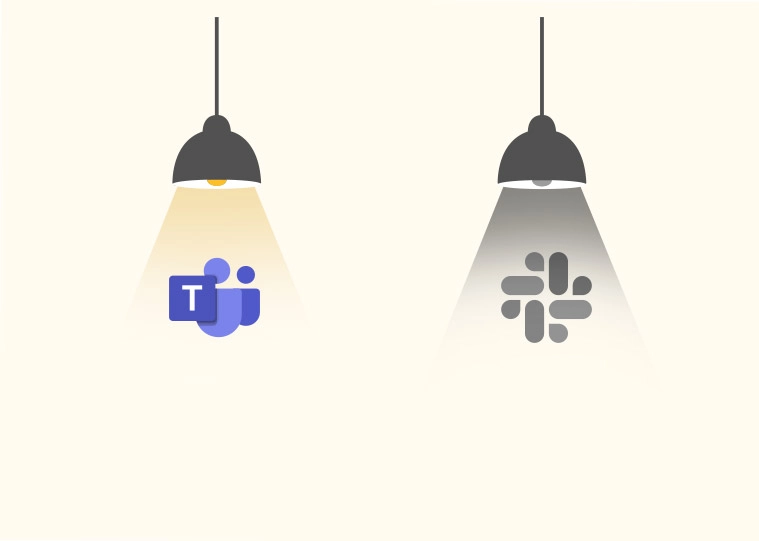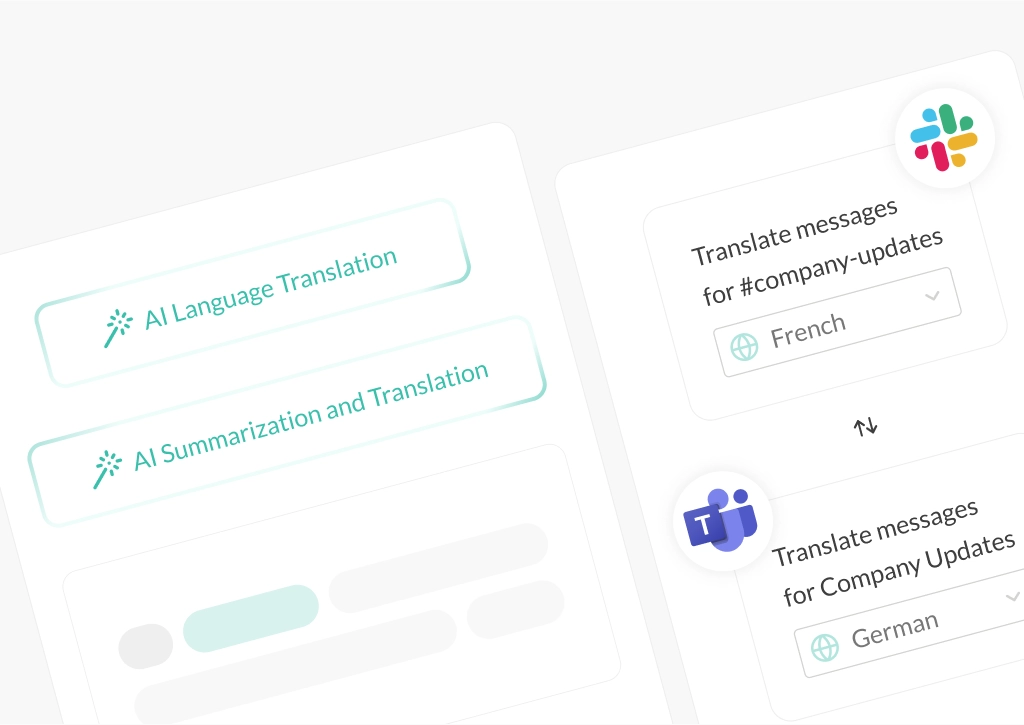Shadow IT: How to Control Shadow Messaging on Slack and Teams

Shadow IT is one of the biggest hidden risks in modern workplaces – and it’s evolving. No longer just about unsanctioned apps or file-sharing tools, shadow IT is now creeping into how teams communicate day-to-day.
According to one report, 80% of workers use software not cleared by IT. This growing trend of shadow IT now extends to messaging itself, creating gaps in knowledge, siloed decisions, and communication breakdowns across departments and tools.
In this article, we’ll break down what shadow IT is, how shadow messaging shows up in Slack and Teams, what risks it creates, and how your business can fix it, including how Conclude Connect helps unify communication across platforms.
What Is Shadow IT?
Shadow IT is the use of software, apps, or communication tools within a company without approval or oversight from the IT department.
It usually starts when teams or individuals find faster, easier ways to get work done — using tools that aren’t officially sanctioned. While often well-intentioned, shadow IT can bypass security policies, introduce compliance risks, and scatter important data across platforms that IT can’t monitor or support.
Examples of Shadow IT
Shadow IT can take different forms, from simple software applications to complex cloud services, especially when there’s no IT oversight or approval involved:
- Email accounts – using personal email accounts for work-related communication
- Cloud storage – utilizing services like Dropbox or Google Drive for sharing or storing files
- Project management tools – Employing tools like Trello, Monday, Asana, or Notion as a way to manage projects and tasks
- Software development tools – accessing development tools and environments along with non-enterprise versions of ChatGPT or other GenAI tools
- Conference tools – downloading tools or plug-ins from conferences
- Messaging apps – using messaging platforms outside of approved workflows, such as Teams, Slack, Google Chat, or even WhatsApp
In fact, messaging apps have become one of the biggest contributors to modern shadow IT. According to Mio’s Messaging Report, employees use an average of 3.3 chat apps in their day-to-day communications.
This growing trend, known as shadow messaging or shadow communication, is creating major blind spots in how companies communicate and collaborate.
How Much of a Problem Is Shadow Messaging?
Although it’s difficult to quantify, Gartner is cited in various articles as stating that Shadow IT accounts for 30-40% of IT spending, while the Everest Group has published a figure closer to 50% or more.
However, Capterra admits that while teams using unsanctioned tools may increase cybersecurity risk, they are often creating something valuable for the organization.
In their survey of 300 IT professionals, 94% also stated that IT project managers – seen as the bridge between IT and the business – have an important role to play in fostering a collaborative culture and helping with the adoption and integration of tools into the wider organization.
Shadow Messaging on Slack and Microsoft Teams
Shadow messaging is a growing subset of shadow IT, and one of the most common sources of communication silos in modern organizations. It’s especially visible in companies that use both Slack and Microsoft Teams. As more teams collaborate across departments or with external partners, unsanctioned, unmonitored conversations start to emerge.
The problem becomes even more complex when there’s no official connection between Slack and Teams. Without visibility across platforms, IT can’t monitor usage, enforce security policies, or guarantee that important decisions are properly captured or retained, causing long-term risks.
Risks of Shadow Messaging
Shadow messaging may seem harmless, but it introduces serious threats that can impact team alignment, data security, and operational efficiency at scale. Here are some of the most common shadow chat risks:
- Lost knowledge – messages sent in unmonitored tools or disconnected channels often contain crucial updates or decisions that never make it into official documentation or systems
- Compliance gaps and liability – when sensitive information is shared outside approved platforms, companies risk violating data protection policies or industry regulations
- Siloed communication – if different departments use different tools, cross-functional work becomes disjointed, causing workplace silos
- Work duplication – without a single source of truth, teams often recreate work that’s already been done elsewhere, wasting time and increasing frustration
- Invisibility to IT – unapproved or unofficial channels fly under the radar. Without the right oversight, IT can’t intervene, support users, or ensure proper data handling
Common Causes of Shadow Messaging
Shadow messaging often emerges not from intentional policy-breaking, but from practical needs or organizational challenges. These are some of the most common drivers:
- Mergers & Acquisitions – when two companies with different chat ecosystems come together, unifying can take time. Teams often continue using Slack or Microsoft Teams based on what they’re used to, creating disconnected communication in the meantime
- External collaborations – customer-facing teams like Sales and Support, as well as digital agencies, often need to use the chat tools their clients or partners prefer. If one side uses Slack and the other uses Teams, teams end up working outside official channels just to keep communication flowing
- Department-specific workflows – different teams often have unique requirements. Developers might rely on Slack for its ecosystem integrations, while Operations prefer Teams for its other features and integrations
- Lack of clear policy - if employees aren’t told which tools to use – and what’s off-limits – they’ll usually choose what feels easiest. Without clear policies and enforcement, unofficial apps are more likely to appear
- Inflexible or incomplete tooling – when official messaging tools don’t support specific features or use cases (like messaging formats, integrations, or guest access), teams resort to their own workarounds
How to Solve Shadow Messaging in Slack and Teams
Solving shadow messaging isn’t just about restricting tools; it’s about understanding why it happens and making it easier for teams to communicate effectively within the right guardrails. The goal is to reduce risk without sacrificing productivity.
Here are four steps to help your organization address shadow messaging:
1. Audit Current Messaging Tool Usage
Start by mapping out which tools are in use across departments. You may discover that some teams are using unofficial Slack workspaces, Teams chats that aren’t monitored, or external messaging apps like WhatsApp being used for business purposes.
2. Identify Shadow Messaging Hotspots
Look for patterns. Shadow messaging is especially common in IT (where on messaging platform is preferred) or in customer-facing departments, where teams must adapt to client tools. It’s also common post-M&A, where teams continue using legacy platforms from their previous organizations.
3. Communicate Policies Clearly
Define exactly which messaging tools are sanctioned, what’s off-limits, and what the consequences are. Recently, some companies have even started to block messaging apps to eliminate non-compliant communication.
4. Monitor and Evolve Over Time
Shadow messaging isn’t a one-time fix – it doesn’t disappear after one policy change. Check in regularly to see how tools are being used, stay responsive to evolving team needs, and adapt your policies and solutions to support real-world workflows.
The most effective solution, however, isn’t just monitoring; it’s eliminating the need for workarounds altogether. That’s where chat interoperability comes in, and where Conclude Connect can help.
Conclude Connect: A Better Way To Bridge Slack and Teams
If your organization is struggling with shadow messaging between Slack and Microsoft Teams, you don’t need to force everyone to use one tool.
Conclude Connect is built to unify communication across Slack and Microsoft Teams – without requiring people to change where they work. This solution allows team members from different workspaces, teams, and channels to chat directly with each other, or in shared, connected channels, while sharing files and more.

What can Conclude Connect do?
- Two-way syncing between Teams and Slack, for a native, real-time communication experience
- Connect Slack and Teams channels
- Connect Microsoft Teams chats with Slack
- Set up internal connections (company-wide) to unify communication
- Use external connections (with outside collaborators) to keep messages flowing
- Sync threaded messages, add emoji reactions and @mentions
- Set up secure file sharing options, including rules for document and image sharing
- Admin controls to manage communication and control security
By letting people stay in the tool they prefer, Conclude Connect reduces the possibility of shadow messaging. It keeps teams aligned, reduces risk, and makes communication smoother across the entire organization.
Unify Slack and Teams to Fix Shadow Messaging
Shadow messaging isn’t just a technical issue; it’s a business risk. When conversations happen outside of official channels, knowledge gets lost, decisions aren’t documented, and collaboration becomes fragmented.
While there are several ways to reduce the risks of shadow messaging – like auditing usage, setting clear policies, and increasing visibility – the simplest solution is often to embrace messaging interoperability.
Tools like Conclude Connect offer a smarter approach, so you don’t have to choose between platforms. You can bridge Slack and Teams, letting teams work in the platform they prefer, without compromising visibility, consistency, or compliance.
Ready to take control of shadow messaging? Try Conclude free for 14 days.
Frequently Asked Questions
What is shadow messaging in workplace chat?
Shadow messaging refers to any work-related communication that takes place outside of official, monitored messaging platforms sanctioned by IT. These can be tools like WhatsApp or Google Chats, or even specific channels inside Slack and Microsoft Teams. Shadow messaging often leads to lost context, compliance risks, and communication silos.
How does shadow messaging impact teams?
Shadow messaging causes critical issues across productivity, alignment, and compliance. ** ** When conversations happen outside approved tools, decisions go unrecorded, knowledge is duplicated or lost, and teams become misaligned. It also exposes organizations to security and regulatory violations.
Can shadow messaging be secure?
Shadow messaging usually happens outside of IT’s oversight, which means messages may not be encrypted, retained, or monitored properly. Without control over the platform, businesses face greater compliance risks and data exposure.
In Cisco’s research on large enterprise customers across the US and Europe, almost one-third of unsanctioned cloud services used by employees were considered high-risk to the business.
Why is chat interoperability crucial?
Chat interoperability can be one of the simplest ways to reduce any shadow messaging risks. By linking messaging apps like Slack and Microsoft Teams, it removes communication silos, improves productivity, and eliminates the need for unsanctioned tools.
How do I address shadow messaging in Slack and Teams?
One of the most effective solutions is to unify communication between Slack and Teams to eliminate the possibility of shadow messaging altogether.
Conclude Connect links channels and chats between Slack and Microsoft Teams, enabling employees to collaborate across platforms in real-time without switching tools or using unsanctioned apps. As a result, you eliminate silos, maximize productivity, and remove any shadow messaging risks.
This blog was last updated in September 2025.
 Sian Bennett
Sian Bennett

